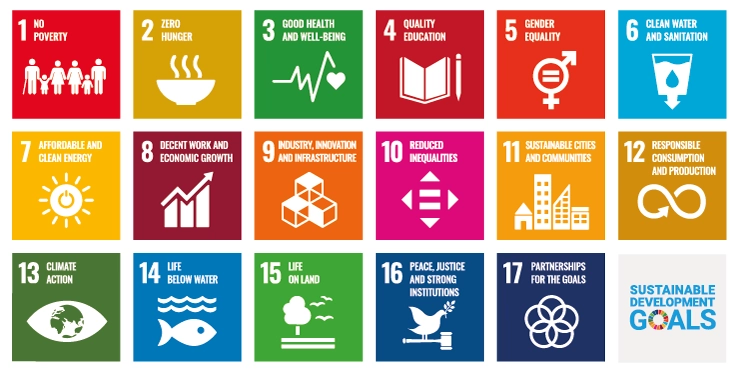Trends
Trends
OCT
07
2022
Social
Towards a fairer, more connected and sustainable environment
Cellnex takes stock of its most important initiatives linked to Sustainable Development Goals
Almost two years have passed since the company’s first CSR plan came to an end in December 2020. With a 90% success rate in meeting the objectives established in 2016, the plan ended to give way to a new proposal that is both more ambitious and committed to ESG (Environment, Social and Corporate Governance) policies to be materialised through the Master Plan 2021-2025.
One pillar of the project has been Cellnex’s contribution to the Sustainable Development Goals, signed by all United Nations Member Countries and which undeniably requires the involvement of society as a whole —including the business sector— to meet the requirements of the 2030 Agenda.
To do this, the company performed a study in which it identified and prioritised, out of the seventeen SDGs, those most relevant to the company, aligned with its operational strategy and organisational culture. These would mark the roadmap for a series of initiatives at all levels of the company.
A little less than halfway through the Master Plan, and to mark the seventh anniversary of the SDGs, Cellnex is taking stock of the Good Practices that have marked this path towards building a fairer, more connected and more sustainable world.
Climate change and biodiversity conservation
Growing with a long-term sustainable environmental proposal is a priority and a cross-cutting commitment. That is why the company has defined a series of actions that can substantially impact on SDG 13 (Climate Action) and 15 (Life on Earth).
Examples of this are monitoring the consumption of fossil fuels and electricity, calculating the carbon footprint and setting specific goals for reducing emissions, validated by the Science Based Targets Initiative (SBTi) and aligned with a 1.5ºC scenario.
In addition to this, actions were implemented to respect and minimise Cellnex’s impact on natural spaces and biodiversity, such as incorporating tools to identify and assess compliance with legislation on biodiversity issues (SALEM); or determining which sites are in protected areas, to track their progress and apply measures where necessary (DaNA). Another initiative worth highlighting is Nest Baskets, the operational efficiency project that in turn promotes conservation of migratory birds nesting in telecommunications towers.
Commitment to Human Rights
There is an obvious connection between human rights and the activity of any company. As part of its ESG agenda, in 2021 Cellnex initiated a process of Due Diligence and Risk Impact Assessment in terms of Human Rights, to identify and address the relevant risks for everyone directly and indirectly involved throughout the entire value chain. This cross-cutting project involved eleven operating areas within the Group and has enabled it to foster actions linked closely to SDG 8 (Decent Work and Economic Growth).
The methodology used was inspired by the Human Rights-Based Approach (HRBA), a conceptual framework of international norms and standards for a life of dignity, the UN’s Guiding Principles on Business and Human Rights, and the OECD’s Due Diligence Guidance for Responsible Business Conduct.
The process represents a complete roadmap to prevent, address and mitigate the impacts that any action related to the business may have on employees, suppliers, the community and its main stakeholders.
Fostering talent while being diverse and inclusive
Without a doubt, one pillar of the organisation’s success is its staff, something that the nearly three thousand employees from the twelve countries that make up the Group know first-hand. To foster growth based on values of Equity, Diversity and Inclusion, Cellnex has rolled out the EDI programme to bring to the fore the differences that help individuals and company to grow.
One of the Programme’s commitments, which directly influences SDG 5 (Gender Equality), is to promote equal opportunities and encourage gender equality at all levels. In this regard, Cellnex has joined initiatives to contribute to female leadership and the full representation of women in economic life, such as Target Gender Equality and Technovation Girls.
It also incorporated the practice of the Blind Curriculum Vitae in outsourced selection processes to avoid bias and discrimination. Along the same lines, it launched the “Unconscious bias” project, a series of educational workshops for employees focused on raising awareness, identifying and preventing the influence of various social stereotypes.
Likewise, with a view to professional advancement and putting more women in managerial roles, the company started the Acceleration Programme for Women, focused on promoting key skills such as communication, relational skills and leadership style. This project affects SDG 4 (Quality Education) as do the series of actions focused on growing the potential of everyone in the organisation, among which we would highlight: the Cellnex MBA, Talent Review, Career Development Assessment Framework and the Global Mentoring Program.
Innovation as a facilitator of sustainable development
The telecommunications sector is at the top of the ranking of sectors that contribute most to the SDGs through innovation —78%—, according to data from the Global Compact.
Cellnex itself has a powerful innovation area, responsible for monitoring and applying new technologies that may have an impact on business and society. Projects that influence different areas such as the fight against the digital divide, the space industry, connected vehicles, sustainable mobility, artificial intelligence or management of critical infrastructures and therefore have a strong involvement with SDG 9 (Industry, Innovation and Infrastructure).
Through its Cellnex Bridge acceleration programme for start-ups with a social and environmental impact, the Cellnex Foundation also plays a key role in promoting innovative projects to reduce digital, social and territorial divides through connectivity.
2030 is coming closer every day, and then we will know the extent of global efforts, but what is clear today is that digital connectivity and companies’ ESG contribution are essential to achieving sustainable development of economic activity, increased productivity, driving innovation and providing territorial and social structure.


















